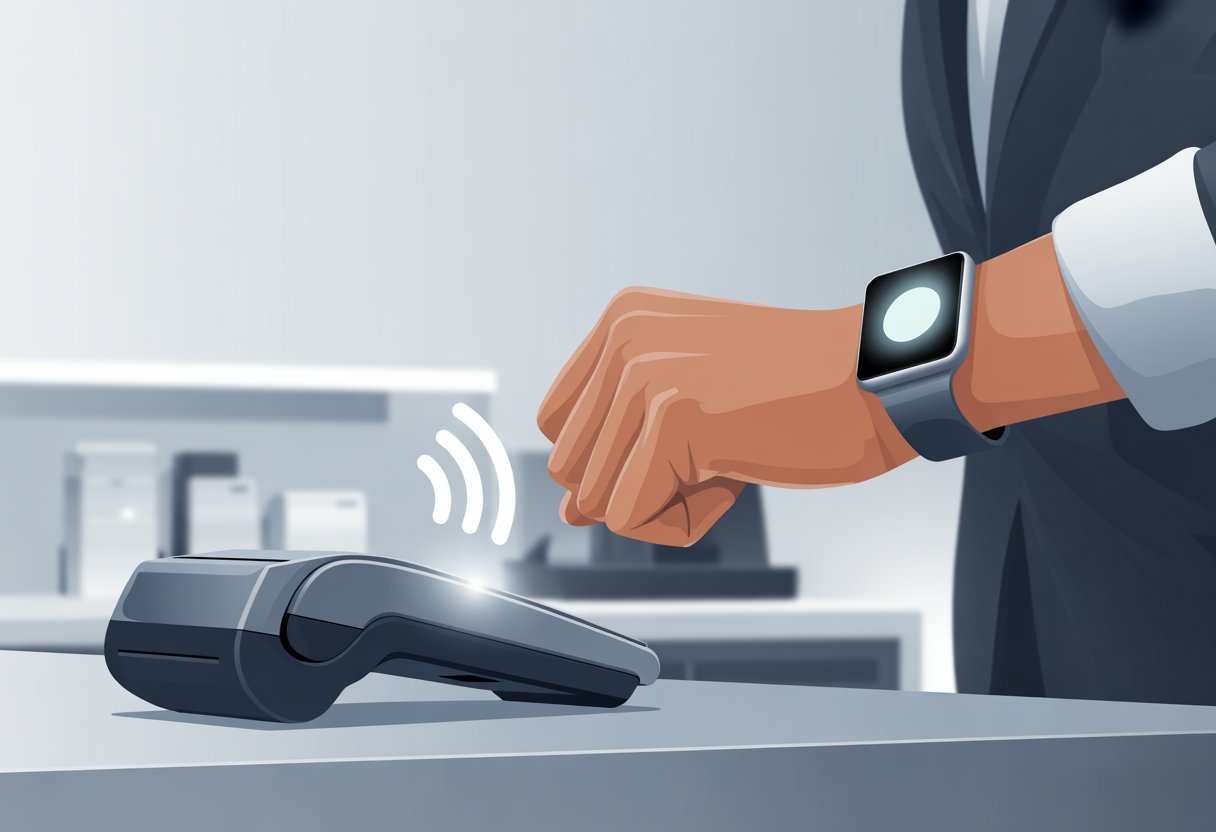Ever wish you could pay for your coffee without digging through your bag, or worse, realizing your wallet is at home with your dignity? Now, with contactless payments on our smartwatches, we can just hold our wrist near the card reader and buy stuff. It’s fast, a little futuristic, and honestly, it makes us look cool (or at least, less clumsy).

Contactless payments have popped up everywhere—grocery stores, train stations, you name it. No more fumbling for cash or digging out a card. Our smartwatch takes care of it in seconds, sometimes before the cashier even asks, “Would you like a receipt?”
If you’ve ever waved your wrist at the checkout and wished it would just pay, you’re in the right place.
Let’s break down how to set up these features so next time someone says, “that’ll be $3.50,” we can handle it with a flick of the wrist and maybe a smug little grin.
Understanding Contactless Payments With Smartwatches
Paying with your wrist sounds fancy, but there’s real tech working behind the scenes. We’ll dig into how contactless payments work, how our smartwatches turn us into walking credit cards, and which platforms make the magic happen.
What Are Contactless Payments?
Contactless payments let us pay by tapping or waving our device or card near a reader. This all runs on NFC (Near Field Communication).
No swiping, dipping, or awkward PIN entry in front of strangers. Just a tap, and our money is gone with a wave—sometimes literally.
We’ve seen this with tap-to-pay cards, but smartwatches use the exact same tech. It’s secure because our info never gets handed over completely—it’s like our card is playing peekaboo with the store.
How Smartwatches Enable Payments
A smartwatch becomes a tiny credit card on our wrist when it comes to payments. Inside, it’s got an NFC chip, just like those plastic cards.
When we want to pay, we unlock the watch—maybe with a code, pattern, or our fingerprint—open the payment app, and hold it near the payment reader. The reader says “hello,” and our watch gives a digital handshake. No germs, no fuss.
We can usually pay even if we left our phone at home, as long as the watch already has a payment app set up. Most major banks are on board, and some watches let us store several cards at once.
If you want step-by-step help, check out Google’s guide on paying with your smartwatch.
Popular Payment Platforms
Three big names run the show here: Apple Pay, Google Pay, and Samsung Pay. Each one has its own quirks:
- Apple Pay works on Apple Watches and keeps things safe with Face ID, Touch ID, or a passcode.
- Google Pay is found on Wear OS watches and lets us tap-to-pay, even if our phone isn’t nearby for a few transactions (because sometimes, we really do leave our phone at home).
- Samsung Pay runs on Samsung smartwatches and supports both NFC and, on some models, MST, so it works at more places.
These platforms use some pretty advanced security. Our card details never get shared; instead, a one-time code goes out every time we pay. It’s easy, secure, and—let’s face it—makes us feel like secret agents buying coffee.
If you want to nerd out on the differences, WIRED has a great breakdown on how to pay with a smartwatch and which models work with what.
Setting Up Your Smartwatch for Payments
Getting ready to pay with your smartwatch takes a few steps, but it’s not rocket science. We just need to add a bank card, pick the best payment app, and lock things down so nobody buys snacks with our wrist when we’re not looking.
Adding Your Credit Card or Payment Card
First up, we need to add a card to our smartwatch wallet. For Apple Watch, we open the Wallet app on our iPhone and tap “Add Card.” Then we scan or type in our card info and maybe verify with a text or email.
On Android watches, we look for the Google Pay or Samsung Pay app, depending on which we’re rocking. Google Pay lets us tap “Add Card” and either snap a photo or type the numbers. Samsung Pay is similar—open, hit the plus sign, and follow the steps.
Some watches, like Fitbit, also support payments. In the Fitbit app, we pick our device, tap “Wallet,” and add our card just like the others. Just make sure your bank is supported, or you’ll be stuck paying the old-fashioned way.
Configuring Payment Apps
Not all smartwatches use the same payment apps. Apple Pay is for Apple Watch, Google Pay is on many Wear OS devices, and Samsung Pay is for Galaxy watches. The right one depends on what you’re wearing.
Setting up Google Pay means opening the app on your watch, signing in with your Google account, and following the prompts. Samsung Pay wants a Samsung account and sometimes its own PIN just for payments. Apple Pay is tied to your Apple ID—sometimes it feels like Tim Cook is watching.
Most apps let us pick a default card if we’ve got more than one. We can turn on notifications, manage cards, and even enable “pay without unlocking” if we trust our gym buddies. If you get stuck, there’s usually a “Help” section hiding somewhere in the settings.
Securing Your Watch With a Passcode
Nobody wants a stranger buying pizza with their smartwatch. That’s why we need a strong passcode, PIN, or maybe even Touch ID on Apple Watch.
For Apple Watch, a passcode is required for Apple Pay. We set it in the Watch app under Passcode settings—just don’t pick “1234.” On Wear OS, we set a PIN or pattern in the “Security” menu. Samsung Pay will nudge us to make a payment PIN, adding another layer of protection.
Fitbit smartwatches also support “wallet locks.” Just remember your code or risk standing at the checkout looking confused. Seriously, don’t write it on your hand.
Making Payments With Your Watch
Contactless payments with a smartwatch save us from fishing for wallets and juggling cards. The process might look high-tech, but it’s simple, secure, and—let’s admit it—pretty fun.
How To Use Your Watch to Pay
Before we start waving our wrists like wizards, we need to make sure our smartwatch is ready. Most modern watches—Apple Watch, Samsung, Garmin, Wear OS—support contactless payments.
If we haven’t already, we add our preferred card to the wallet app on our watch.
Activating payment mode usually takes a button press. On many watches, we double-click the side button to bring up our cards. Then we pick the card we want.
It’s honestly more exciting than shuffling plastic at the checkout.
As long as we’re at a place that takes contactless payments, our watch does the rest. No phone needed—just our stylish wrist gadget and a dash of confidence.
We call it “tap and go,” but really, it’s more like “tap and impress.”
Interacting With Payment Readers
When it’s time to pay, we look for the contactless symbol on the reader. It usually looks like a sideways Wi-Fi logo waving at our watch.
Standing too far away or flailing our arm won’t help. The watch needs to be close—just a few centimeters from the reader.
We hold our watch steady over the reader and let the magic happen. If nothing happens, don’t panic; just hold still a second longer.
Some payment readers need patience. Others react before we even blink.
Common mistakes? Standing there too long or pulling away too soon. If we’re unsure, watching other shoppers can help, but nothing screams “new to this” like a panicked glance at the cashier while our wrist hovers in midair.
Recognizing Successful Payments
Success in contactless payments comes with perks—sound effects and little vibrations. Most watches vibrate or play a sound when the payment goes through.
That’s our cue to relax and stop holding our wrist like a trophy.
A check mark usually pops up on the watch face, confirming the transaction. Some watches even show the amount paid or which card we used, just to make sure we didn’t “accidentally” buy fifty donuts.
If nothing happens, or if a red X shows up, the payment probably didn’t go through. Try again, get closer, or ask if the place supports contactless.
If all else fails, there’s always the old-fashioned card—or interpretive dance while your watch tries to impress the reader.
Managing Cards and Payment Methods
Let’s be honest, most of us have a pile of payment cards in our wallets. Luckily, our smartwatches can handle more than one card, so we don’t have to pick favorites.
With just a few taps, we can switch between options as we pay.
Using Multiple Cards
Most modern smartwatches let us add several cards to our digital wallet. That means we can carry our credit card, debit card, and maybe even a rewards card—all on our wrist.
It’s like having your entire wallet, minus the receipts and old loyalty punch cards.
To add a card, we open the payment app—Google Pay, Apple Pay, Garmin Pay, whatever—and follow the instructions to scan or enter our card details. Here’s the gist:
- Open your smartwatch’s wallet app
- Tap “Add card” or a “+” symbol
- Enter or scan card info
- Follow verification steps (usually a text or email code)
Most payment apps let us add a handful of cards, so even that funky store card can join in. We can view all our cards in the app and set one as the default, ready for checkout.
Some smartwatches need us to verify the card with our bank, which usually takes a minute and, sadly, doesn’t come with confetti.
Switching Payment Methods
Let’s say we’re at the grocery store and want to use a rewards card instead of our usual credit card. No problem.
Our smartwatch makes this easy—and way less awkward than digging through bags at the register.
Here’s how we usually switch cards before paying:
- Double-press (or long-press) the payment button on the watch
- Swipe left or right to flip through available cards
- Tap the card we want for this payment
Once we’ve picked our card, we hold our watch up to the contactless reader like usual.
If you’re using Apple Watch, double-tap the side button and pick the right card, as shown in this guide for paying with an Apple Watch. Google Pay and Samsung Pay work pretty much the same way.
Switching cards happens before the payment goes through, not after, so if we grab the wrong one, just swipe again—no embarrassment required.
We get control, speed, and a little style every time we flick our wrist.
Safety, Security, and Privacy Features
Using a smartwatch for contactless payments feels convenient, but we have to stay sharp about protecting our info. Passcodes and wallet locks keep our cash safe, right from our wrists.
Why Use a Passcode or Touch ID?
Let’s face it—our wrists aren’t immune to nosy friends or sticky fingers. Setting a passcode on your smartwatch works like a tiny digital bouncer, blocking anyone from making payments without your say-so. If they don’t know the pin, they’re out of luck (even if they’re a wizard).
Touch ID, if your watch has it, adds a fingerprint to the mix. Just tap your finger and boom—access. No need to remember another code. If someone tries the wrong passcode too many times, the watch usually locks up tight, like our secret snack stash.
Understanding Wallet Locks
Wallet locks quietly guard our smartwatches. They keep our saved cards from being easy targets. Think of a wallet lock as a “Do Not Disturb” sign for payment info—nobody gets in unless we give the green light.
We can set the lock to kick in after a set time or when we take the watch off. If someone else slips our smartwatch onto their wrist, they can’t just buy themselves a latte. If you want more details, the Google Wallet Help page breaks it down.
Key benefits:
| Feature | Benefit |
|---|---|
| Passcode | Prevents unauthorized payments |
| Touch ID | Quick, fingerprint-based security |
| Wallet Lock | Secures cards when watch is off the wrist |
Benefits of Using Smartwatches for Payments
Paying with a smartwatch feels a little bit magical—no frogs or spells required. From ditching the wallet to keeping things cleaner, smartwatches like the Apple Watch or Fitbit make life smoother and, honestly, a bit cooler.
Convenience in Everyday Life
Our pockets are already jammed with keys, cards, and who knows what else. Carrying less? Always a win. With contactless payments on a smartwatch, we can just flick our wrist and pay.
When we’re juggling groceries or wrangling kids, it’s a lifesaver. Grocery store, gas station, coffee shop—it works at most places that take tap-to-pay cards. Apple Pay, Google Pay, Samsung Pay—they’re all ready to go on our wrists, so we’re not stuck digging around for a card. You can check out more perks from different smartwatches offering payment features.
If we forget our phone at home, it’s fine! We can still grab a snack or treat ourselves to that last slice of cake. That’s freedom, right?
Speed and Hygiene
Ever fumbled for a card with a line of impatient shoppers behind you? With a smartwatch, it’s just tap-and-go. No wallet digging, no backpack rummaging.
We get to skip the keypad, which keeps our hands cleaner—especially nice in crowded stores or when cold season hits. Paying with a watch is actually highly secure because of things like virtual card tokenization.
Sometimes, merchants look genuinely impressed by the quick payment. Makes us feel like tech wizards (with extra clean hands).
Added Features and Integrations
There’s more to these smartwatches than just paying for coffee. Many can show payment history, so we can track where our coffee money goes. Switching between cards is easy—just a few taps or swipes.
Some watches offer rewards or loyalty perks that connect with payment apps. Fitbit smartwatches can support special offers or track spending alongside your fitness stats. That’s a combo we can get behind. If you want to see what else smartwatches can do, check this guide.
Our watches keep things seamless, putting all the payment and perk power right on our wrists—no purse-hunting required (or even pants, if we’re honest).
Battery Life and Performance Tips
Smartwatches need to keep up with our busy days. Managing features like contactless payments and heart rate monitoring can make a real difference in battery life.
Impact of Contactless Payments on Battery
Contactless payments are quick and, honestly, kind of fun. The good news? Using NFC for payments barely touches the battery compared to streaming music or tracking workouts.
When we tap to pay, the NFC chip wakes up for a few seconds—hardly enough to notice on the battery meter. But if we leave the payment app running or crank up the screen brightness, it starts to add up.
Here’s a quick tip list to stay energy efficient:
- Close or exit payment apps after use.
- Lower your screen brightness.
- Don’t let the watch screen stay awake longer than needed.
Regular payments won’t leave us scrambling for a charger, but smart habits help.
Managing Heart Rate Monitoring for Efficiency
Our smartwatches love checking our pulse—maybe too much. 24/7 heart rate tracking can drain the battery way faster than the occasional payment. If we’re not working out or worried about our heart, do we really need the constant monitoring?
We can save battery by turning off heart rate monitoring or switching from continuous to manual mode. Most watches let us pick how often it checks—every minute, every ten minutes, or just when we ask.
Turning off always-on screens and background fitness tracking also helps. For more battery-saving tips, check out this guide. Sometimes, it’s best to let our smartwatch take a short breather.
Troubleshooting Common Issues
We’ve all tried waving our wrist like a Jedi, only to get ignored by the payment reader. Sometimes it’s a quick fix, sometimes it’s just not our day. Either way, let’s break down some common problems and how we can outsmart them.
When a Payment Doesn’t Go Through
Don’t panic if your smartwatch wave gets snubbed. First, make sure the watch is snug, unlocked, and the payment app (like Google Pay) is open and ready. Some readers want the smartwatch right up against them—no half-hearted waving.
If nothing happens, try a quick restart for both the watch and your phone. Double-check that NFC is on, since no NFC means no payment. If things are still stuck, removing and re-adding the card in the app can work wonders—sometimes it’s like taming a moody vending machine.
For more steps, check this troubleshooting list.
Problems With Card Setup
Sometimes, a card just won’t play nice. Maybe we typed something wrong, or maybe the bank’s being picky. We should check that the card details match the physical card, right down to the last digit.
If the payment app still won’t accept our card, maybe the bank doesn’t support contactless payments with our smartwatch model. It’s always worth checking for software updates, too—outdated apps can cause weird problems.
When all else fails, try removing and re-adding the card. Sometimes, smartwatches just need a little nudge.
Issues at Participating Locations
Not every store has a payment reader that’s up to date. Some of these things look at our wrist and just shrug, refusing to recognize our fancy future-tech moves.
So, before you go full spy mode at the checkout, always check for the contactless payment symbol. It saves a lot of awkward waving.
Sometimes, the payment reader just isn’t having it. Maybe it’s an older model or just being stubborn today.
Try using a different terminal if you can, or just ask the cashier for help. That usually works, honestly.
If a place claims they accept contactless but your watch keeps getting rejected, double-check with the staff. You might not be the only one dealing with this.
For more real-life headaches, there’s a whole contactless payment discussion for Galaxy Watch. Sometimes, it’s definitely not us—it’s them.
- Best Bluetooth Headphones for Airplane Travel: Drown Out Crying Babies in Style - December 8, 2025
- How to use Bluetooth headphones with an intercom system and Finally Escape Tangled Wires - December 7, 2025
- Best Fitness Trackers for Silent Alarms: Wake Up Without the Drama - December 7, 2025






